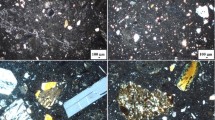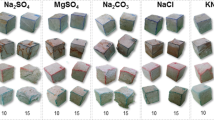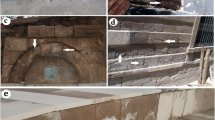Abstract
The deterioration of a stone material is related to its pore structure, which affects the interaction between surface and environmental agents. Indeed, salt crystallization is one of the most dangerous weathering agents in porous building materials. The crystallization pressure of salt crystals, growing in confined pores, is found to be the main cause for damage. The consolidation of such degraded stone materials represents a crucial issue in the field of restoration of cultural heritage. This paper presents the results of a laboratory experimentation carried out on Modica stone, a limestone largely used in the Baroque architecture of eastern Sicily. Several specimens, collected from a historical quarry near the city of Modica, were artificially degraded by salt crystallization tests. Then, degraded samples were treated with three different consolidating products: a suspension of nanolime in alcohol, a suspension of nanosilica in water, and ethyl silicate dispersed in white spirit. A systematic approach, including mercury intrusion porosimetry, peeling tests and point load test, was used to evaluate the correlation between the salt crystallization and the micro-structural features of the limestone, as well as the efficacy of treatments. The consolidating behavior of the tested products was also appraised by repeating salt crystallization tests after consolidation, in order to assess the resistance of treated stone to further salt crystallization phenomena. Results showed that nanolime provides a good resistance to the stone; conversely, ethyl silicate, although inducing an enhancement of stone cohesion, leads to an increase of the crystallization pressure, which generates dangerous susceptibility to weathering.








Similar content being viewed by others
References
Angeli M, Benavente D, Bigas JP, Menendez B, Hebert R, David C (2008) Modification of the porous network by salt crystallisation in experimentally weathered sedimentary stones. Mater Struct 4:1091–1108
Arnold A, Zehnder K (1989) The conservation of monuments in the Mediterranean basin, Grafo Edizioni, Brescia, pp 31–58
ASTM D 5731 (2002) Standard test method for determination of the point load strength index of rock
Belfiore CM, La Russa MF, Pezzino A, Campani E, Casoli A (2010) The Baroque monuments of Modica (Eastern Sicily): assessment of causes of chromatic alteration of stone building materials. Appl Phys A 100:835–844
Benavente D, García del Cura MA, Bernabéu A, Ordóńez S (2001) Quantification of salt weathering in porous stones using an experimental continuos partial immersion method. Eng Geol 59:313–325
Benavente D, GarcÌa del Cura MA, Fort R, Ordóñez S (2004) Durability estimation of porous building stones from pore structure and strength. Eng Geol 74:113–127
Cassar J (2010) The use of limestone in a historic context—the experience of Malta. In: Smith BJ, Gomez-Heras M, Viles HA, Cassar J (eds) Limestone in the built environment: present-day challenges for the preservation of the past, vol 331. Geological Society of London, London, pp 13–25
Chelazzi D, Poggi G, Jaidar Y, Toccafondi N, Giorgi R, Baglioni P (2013) Hydroxide nanoparticles for cultural heritage: consolidation and protection of wall paintings and carbonate materials. J Colloid Interface Sci 392:42–49
Dei L, Salvadori B (2006) Nanotechnology in cultural heritage conservation: nanometric slaked lime saves architectonic and artistic surfaces from decay. J Cult Herit 7:110–115
Doehne E, Price CA (2010) The stone conservation: an overview of current research, 2nd edn. Getty Conservation Institute, Los Angeles, p 164
Drdàcky M, Lesàk J, Rescic S, Slìzkovà Z, Tiano P, Valach J (2012) Standardization of peeling test for assessing the cohesion and consolidation characteristics of historic stone surfaces. Mater Struct 45:505–520
Dunham RJ (1962) Classification of carbonate rocks according to depositional texture. In: Ham WD (ed) American Association of Petroleum Geologist Memoir, pp 108–121
EN 12370 (2001) Natural stone test methods—determination of resistance to salt crystallization. European Committee for Standardization (CEN), Brussels, pp 108–121
Espinosa-Marzal RM, Scherer GW (2010) Mechanisms of damage by salt. In: Smith BJ, Gomez-Heras M, Viles HA, Cassar J (eds) Limestone in the built environment: present-day challenges for the preservation of the past, vol 331. Geological Society of London, London, pp 61–77
Everett DH (1961) The thermodynamics of frost damages to porous solids. T Faraday Soc 57:1541–1551
Fitzner B, Snethlage R (1982) Ueber Zusammenhange zwischen Salzkristallisationsdruck und Porenradienverteilung. GP Newsl 3:13–24
Flatt RJ (2002) Salt damage in porous materials: how high supersaturations are generated. J Cryst Growth 242:435–454
Goudie AS, Viles HA (1997) Salt weathering hazards. Wiley, Chichester
Kim EK, Won J, Do J, Kim SD, Kang YS (2009) Effects of silica nanoparticle and GPTMS addition on TEOS-based stone consolidants. J Cult Herit 10:214–221
Koniorczyk M, Gawin D (2012) Modelling of salt crystallization in building materials with microstructure-poromechanical approach. Constr Build Mater 36:860–873
La Russa MF, Barone G, Mazzoleni P, Pezzino A, Crupi V, Majolino D (2008) Characterisation and differentiation of pigments employed on the facade of “Noto’s Valley” monuments (Sicily). Appl Phys A 92:185–190
La Russa MF, Barone G, Belfiore C, Mazzoleni P, Pezzino A (2011) Application of protective products to “Noto” calcarenite (South-eastern Sicily): a case study for the conservation of stone materials”. Environ Earth Sci 62:1263–1272
La Russa MF, Ruffolo SA, Rovella N, Belfiore CM, Palermo AM, Guzzi MT, Crisci GM (2012) Multifunctional TiO2 coatings for cultural heritage. Prog Org Coat 74:186–191
La Russa MF, Ruffolo SA, Belfiore CM, Aloise P, Randazzo L, Rovella N, Pezzino A, Montana G (2013) Study of the effects of salt crystallization on degradation of limestone rocks. Period Mineral 82:113–127
La Russa MF, Macchia A, Ruffolo SA, De Leo F, Barberio M, Barone P, Crisci GM, Urzì C (2014) Testing the antibacterial activity of doped TiO2 for preventing biodeterioration of cultural heritage building materials. Int Biodeter Biodegr 96:87–96
La Russa MF, Belfiore CM, Fichera GV, Maniscalco R, Calabrò C, Ruffolo SA, Pezzino A (2015) The behaviour to weathering of the Hyblean limestone in the baroque architecture of the Val di Noto (SE Sicily): an experimental study on the “calcare a lumachella” stone. Constr Build Mater 77:7–19
Lazzarini L, Laurenzi Tabasso M (1986) II Restauro della Pietra. Antonio Milani, Padova
McCabe S, Smith BJ, Warke PA (2007) Preliminary observations on the impact of complex stress histories on sandstone response to salt weathering: laboratory simulations of process combinations. Environ Geol 52:251–258
Mosquera MJ, Pozo J, Silva B, Rivas T, Esquivias E (2002) Application of mercury porosimetry to the study of xerogels used as stone consolidants. J Noncryst Solid 311:185–194
Mosquera MJ, Pozo J, Esquivias E (2003) Stress during drying of two stone consolidants applied in monumental conservation. J Sol-Gel Sci Tech 26:227–1231
Pinto F, Rodrigues D (2008) The action of inorganic consolidants in limestones. In: Lukaszewicz JW, Niemcewicz P (eds) Proceedings of the 11th international congress on deterioration and conservation of stone, Poland, pp 80–873
Price CA (1975) Stone decay and preservation. Chem Br 11:350–353
Price C (2006) Consolidation. In: Henry A (ed) Stone conservation: principles and practice. Donhead Publishing, Shaftesbury, pp 101–126
Price C (2007) Predicting environmental conditions to minimise salt damage at the Tower of London: a comparison of two approaches. Environ Geol 52:369–374
Rossi-Manaresi R, Tucci A (1991) Pore structure and the disruptive or cementing effect of salt crystallization in various types of stone. Stud Conserv 36:53–58
Ruffolo SA, La Russa MF, Malagodi M, Oliviero Rossi C, Palermo AM, Crisci GM (2010) ZnO and ZnTiO3 nanopowders for antimicrobial stone coating. Appl Phys A 100:829–834
Ruffolo SA, La Russa MF, Aloise P, Belfiore CM, Macchia A, Pezzino A, Crisci GM (2013) Efficacy of nanolime in restoration procedures of salt weathered limestone rock. Appl Phys A 114:753–758
Schaffer RJ (1932) The weathering of natural building stones. Department of Scientific and Industrial Research, Build Res Board, Special Report 18:42–48
Scherer GW (1999) Crystallisation in pores. Cem Concr Res 29:1347–1358
Scherer GW (2004) Stress from crystallization of salt. Cem Concr Res 34:1613–1624
Scherer GW, Wheeler GE (1997) Stress development drying of conservare OHR. In: Moropoulou A, Zezza F, Kollias E, Papachristodoulou I (eds) 4th international symposium on the conservation of monuments in the mediterranean, Rhodes, pp 355–362
Smith BJ, Gomez-Heras M, Viles HA (2010) Underlying issues on the selection, use and conservation of building limestone. In: Smith BJ, Gomez-Heras M, Viles HA, Cassar J (eds) Limestone in the built environment: present-day challenges for the preservation of the past, vol 331. Geological Society, London, pp 1–11 (Special Publications)
Wellman HW, Wilson AT (1965) Salt weathering, a neglected geological erosive agent in coastal and arid environments. Nature 205:1097–1098
Wellman HW, Wilson AT (1968) Salt weathering or fretting. In: Fairbridge RW (ed) Encyclopedia of geomorphology, Dowden, Hutchinson & Ross, Stroudsburg, pp 968
Wheeler GE, Fleming SA, Ebersole S (1992) Comparative strengthening effects of several consolidants on Wallace sandstone and Indian limestone. In: Delgado J, Henriques F, Jeremias F (eds) Proceedings of the 7th international congress on deterioration and conservation of stone, Lisbon, pp 1033–1041
Winkler EM (1997) Stone in architecture, properties, durability. Springer, Berlin, p 315
Yu S, Oguchi CT (2010) Role of pore size distribution in salt uptake, damage, and predicting salt susceptibility of eight types of Japanese building stones. Eng Geol 115:226–236
Acknowledgments
This research was supported by the Italian national project “Polo di Innovazione dei Beni Culturali”.
Author information
Authors and Affiliations
Corresponding author
Additional information
Silvestro A. Ruffolo and Mauro F. La Russa are equally contributed to this work.
Rights and permissions
About this article
Cite this article
Ruffolo, S.A., La Russa, M.F., Ricca, M. et al. New insights on the consolidation of salt weathered limestone: the case study of Modica stone. Bull Eng Geol Environ 76, 11–20 (2017). https://doi.org/10.1007/s10064-015-0782-1
Received:
Accepted:
Published:
Issue Date:
DOI: https://doi.org/10.1007/s10064-015-0782-1




